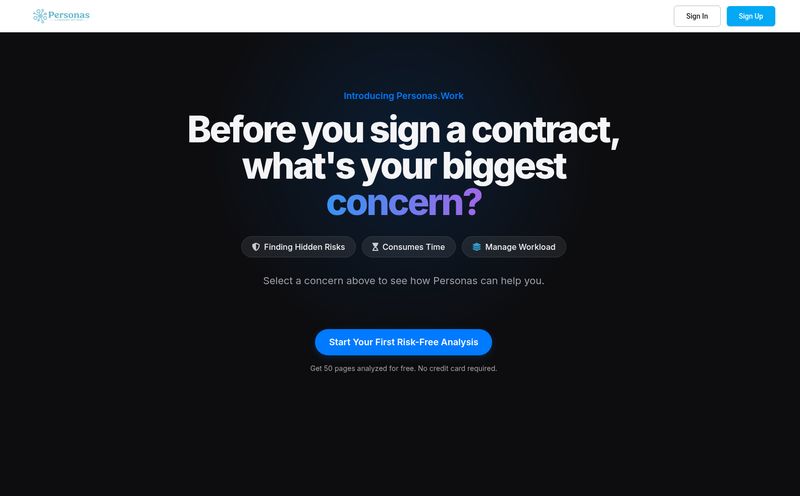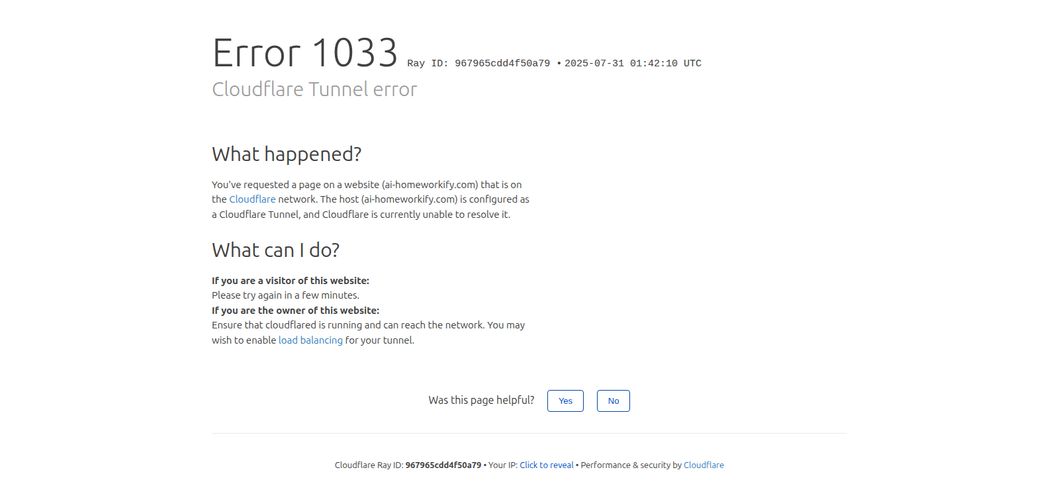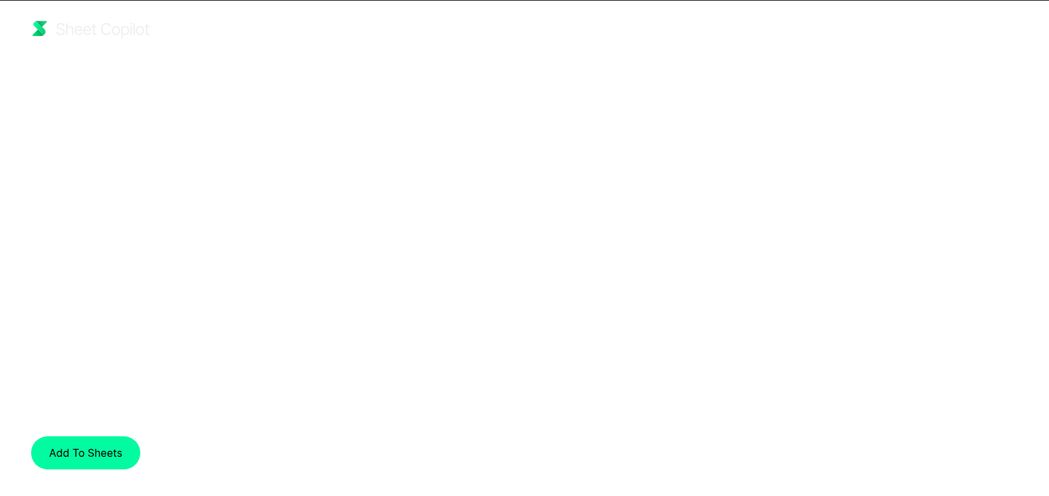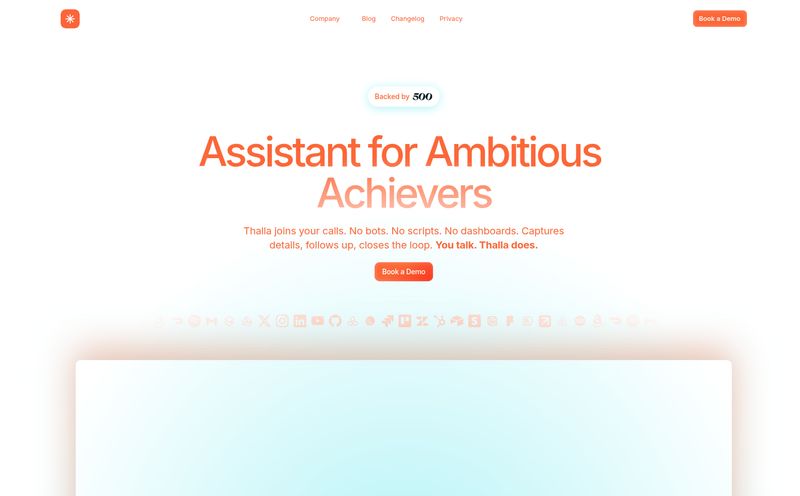The technical interview. Just the phrase is enough to make a seasoned developer's palms sweat. You can have a decade of experience, a GitHub profile that shines, and still, the moment a live coding challenge pops up on a shared screen... your brain just decides to go on a brief vacation. It happens to the best of us.
I've been in the SEO and tech world for years, and I've sat on both sides of that virtual table. I’ve seen brilliant minds freeze up, unable to recall a simple syntax they'd write in their sleep on any other day. The pressure is just… a lot. It’s not always a fair test of your actual skills. It’s a test of your performance under a very specific, very artificial kind of stress.
So, when I stumbled upon a tool called Tech Screen AI, which bills itself as an “Invisible Interview Assistant,” my curiosity was officially piqued. An AI that gives you real-time help during an interview, but is completely invisible to the interviewer on Zoom or Google Meet? Sounds like something out of a spy movie. But is it a game-changer or just a high-tech cheat sheet?
So, What Exactly is Tech Screen AI?
At its core, Tech Screen is a desktop application (for both Windows and MacOS) that acts as your personal, on-demand AI assistant during interviews. Think of it less like a chatbot you have to switch windows to use and more like a secret agent whispering answers in your ear. Its main claim to fame, the thing that makes it different from just having ChatGPT open in another browser tab, is its stealth.
The entire premise is built around being undetectable. When you're sharing your screen for a coding challenge on HackerRank or a system design discussion on a virtual whiteboard, the Tech Screen interface remains visible only to you. The interviewer sees your code, your diagram, your face—but not your AI co-pilot. It’s a pretty bold promise.
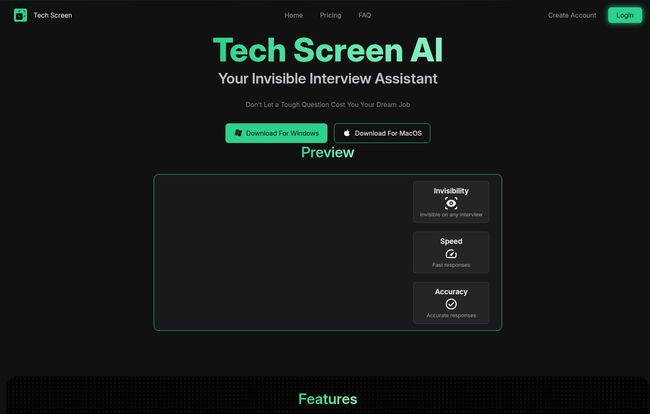
Visit Tech Screen
The Features That Actually Make a Difference
A tool can have a million features, but only a few usually matter in the heat of the moment. After playing around with it, here’s the stuff that stood out to me.
The Invisibility Cloak for Your Screen
This is the big one. The whole reason this tool even exists. The Screen Sharing Invisibility is its golden ticket. I was skeptical, so I tested it. I fired up a Zoom call with a colleague, shared my screen, and ran Tech Screen. Sure enough, I could see the AI interface clear as day, but all he saw was my code editor. No overlays, no weird artifacts. It just works. For anyone who has ever felt that panic of “what are they seeing on my screen?”, this feature alone is a massive anxiety reducer.
No More Fumbling with Windows
The combination of Useful & Intuitive Shortcuts and Active Tab Integration is what makes it practical. The last thing you want during an interview is to be frantically alt-tabbing between screens. Tech Screen is designed to be summoned with a quick keyboard shortcut, and it works on top of whatever application is active. You don’t have to break your flow. You’re in your IDE, you get stuck on a question, you hit the shortcut, ask your question, get the answer, and dismiss it. Smooth.
Getting Answers When the Clock is Ticking
Speed is everything in these scenarios. A long pause can feel like an eternity. The tool promises Fast & Accurate Responses, and in my testing, it delivered. It's quick enough that you can pose a question and get a code snippet or explanation without creating an awkward silence. It felt faster than me manually typing the same query into a standard web-based AI.
Talk, Type, or Show: Flexible Inputs
This part is genuinely cool. The Multi-Input Support means you're not just limited to typing. You can use your microphone to ask a question verbally, which can feel more natural. But the killer application here is the screen-based input. You can select a part of your screen—say, a confusing problem description or a block of code with a bug—and ask the AI to explain or fix it. That's a huge step up from trying to copy-paste everything.
It Speaks Your Language (Literally)
As you'd hope, it has Multi-Language Support. Whether you’re in a Python, JavaScript, Java, or C++ interview, the AI is trained to handle the nuances of different programming languages. It's not a generic chatbot; it's a specialized tool for a technical audience.
Okay, Let's Address the Elephant in the Room: Is This Cheating?
Look, I know what some of you are thinking. “This is just a high-tech way to cheat!” And I get it. I really do. The line between a tool and a crutch can be thin.
Some purists will argue that if you can't answer the question unassisted, you don’t deserve the job. They believe the interview is a sacred test of raw, unaided knowledge and problem-solving skill.
But here’s my take, for what its worth. I see this differently. I don't see Tech Screen as a substitute for knowledge, but as a tool to overcome a flawed and often biased interview process. How many times have you known the answer but couldn't articulate it due to anxiety? This tool acts as a buffer against that performance anxiety. It's like a calculator for a math exam; you still need to know which formulas to apply, but it handles the tedious computation for you.
In my opinion, it can be a powerful accessibility tool. For neurodivergent individuals or those with severe interview anxiety, it levels the playing field, allowing them to demonstrate their true abilities without being penalized by the high-pressure format. You can't use it to fake your way through an entire interview if you know nothing. But you can use it to jog your memory on a specific library function or debug a small syntax error that your anxious brain is overlooking. It helps you show what you know, not pretend to know what you dont.
The Price of a Secret Weapon: Tech Screen's Pricing
Of course, this kind of power comes with a price tag. The model is token-based, where 1 token equals 1 resolved question. It’s a straightforward approach. Here’s how it breaks down:
| Plan | Price | What You Get | Best For |
|---|---|---|---|
| Free | $0 / forever | Unlimited App Access, 3 tokens total | Just trying it out, seeing if it works for you. |
| Essential | $19 / month | 50 tokens/month (~$0.38/token) | The casual job searcher with 1-3 interviews a month. |
| Professional | $29 / month | 160 tokens/month (~$0.18/token) | The serious job hunter who is actively interviewing a lot. This seems to be the sweet spot. |
| Expert | $49 / month | 500 tokens/month (~$0.10/token) | Power users: contractors, freelancers, or those in hyper-competitive fields. |
The free plan is smart—it gives you just enough tokens to test the core features and see if it's a good fit before you commit. The price per token drops significantly as you go up the tiers, rewarding those who are on a serious interview grind.
Any Downsides? A Few Things to Consider
No tool is perfect. While I'm pretty impressed, there are a few potential drawbacks. The website itself mentions that system audio recording can be unstable on some devices, which is something to test if you plan on using the voice input feature heavily. It also requires installation, which is a non-issue for most but could be a hurdle if you’re using a heavily restricted work laptop for your interviews. Finally, the token-based system means you have to be somewhat mindful of your usage, unlike a flat-rate subscription where you can ask unlimited questions.
Frequently Asked Questions About Tech Screen
Is Tech Screen AI really invisible during screen sharing?
Yes. Based on my testing and their core claims, it’s designed to be completely invisible on platforms like Zoom, Google Meet, and others. The interviewer won't see the app's interface.
How fast are the AI responses?
Very fast. The responses are generated in near real-time, quickly enough to not cause an awkward pause in the conversation. It's optimized for the speed needed in a live interview.
What input methods does it support?
It's multi-modal. You can type your questions, speak them using your microphone, or even capture a portion of your screen (like a coding problem) to use as the input.
Does this work for non-technical interviews?
While you could theoretically ask it behavioral questions, its main strength and design are for technical queries—code snippets, algorithms, system design concepts, etc. You'd probably get more value from it in a programming interview than a marketing one.
Is it difficult to set up?
Not at all. You just download the application for your operating system (Windows or MacOS), install it, and you're good to go. The free plan lets you get started without any payment details.
Can I get caught using Tech Screen?
The tool is designed to be undetectable from a software perspective. The biggest risk is human behavior. If you're constantly looking away, pausing unnaturally, or reading answers verbatim, an interviewer might get suspicious. Like any tool, it requires skill to use it discreetly and effectively.
My Final Verdict on Tech Screen AI
So, is Tech Screen AI your golden ticket to a new job? No, not by itself. You still have to do the work, learn the concepts, and have the core skills. But is it a powerful, potentially game-changing tool that can help you overcome the artificial pressures of the modern technical interview? I think so.
It's an equalizer. It’s a confidence booster. It's a way to ensure that a moment of anxiety doesn't derail your chance to prove your worth. If you're heading into the tech interview gauntlet, giving the free version of Tech Screen a try seems like a no-brainer. It might just be the secret co-pilot you need to land your next big role. Go show them what you really know.
Reference and Sources
- Tech Screen AI Official Website
- Tech Screen AI Pricing Page
- How to Manage Interview Anxiety - Harvard Business Review
